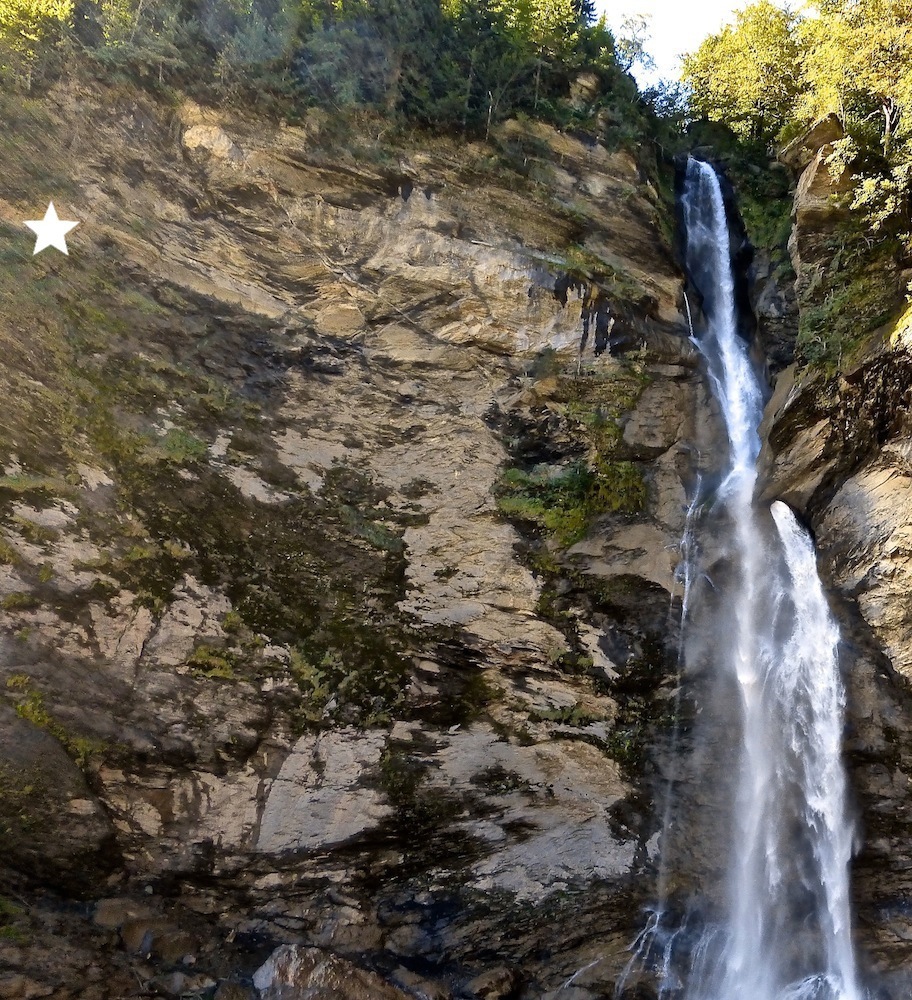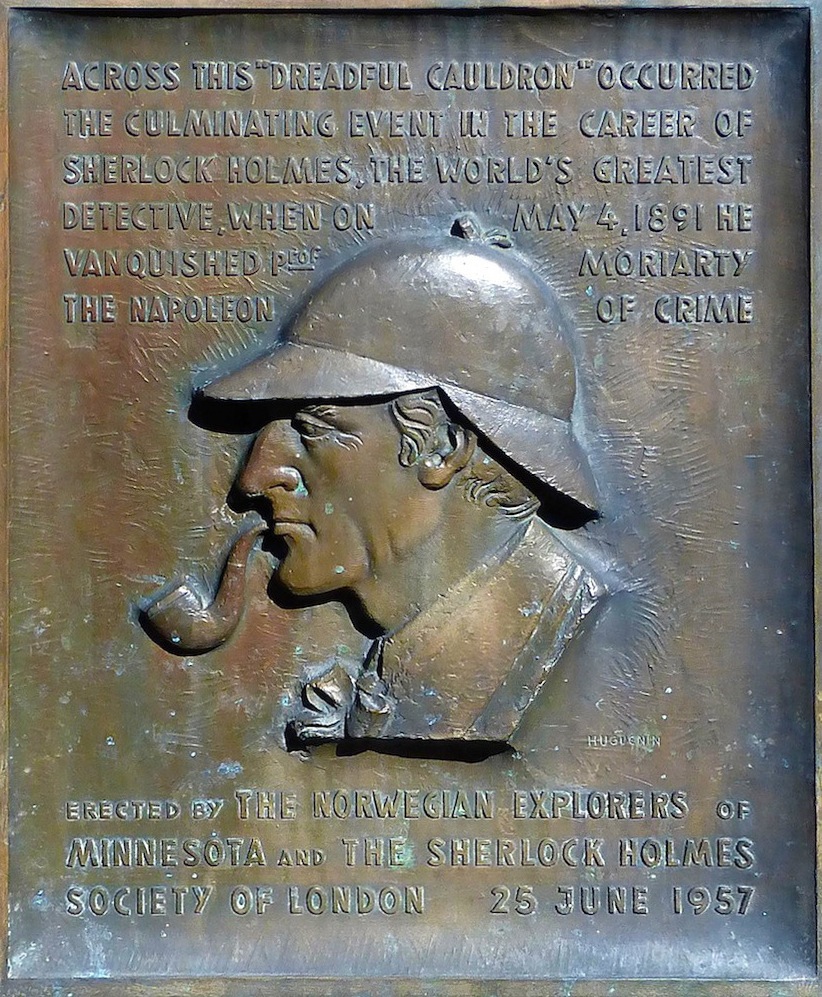
The ledge at the Reichenbach Falls which Arthur Conan Doyle used as the setting for a climactic struggle between his hero, Sherlock Holmes, and Holmes's deadliest adversary, Moriarty.
Arthur Conan Doyle visited the Reichenbach Falls on the outskirts of Meiringen in Switzerland in August 1892, after going out to speak at a meeting in Lucerne. It seemed the ideal place to finish off his hero's adventures. "It is, indeed, a fearful place," as Dr Watson recalls in "The Final Problem":
The torrent, swollen by the melting snow, plunges into a tremendous abyss, from which the spray rolls up like the smoke from a burning house. The shaft into which the river hurls itself is an immense chasm, lined by glistening, coal-black rock, and narrowing into a creaming, boiling pit of incalculable depth, which brims over and shoots the stream onward over its jagged lip. The long sweep of green water roaring for ever down, and the thick flickering curtain of spray hissing for ever upwards, turn a man giddy with their constant whirl and clamour. [337]
Although the falls are no longer so dramatic, spray can still be seen whirling up in the recent photograph above. Watson then describes how a path has been cut into the rock halfway round the falls, and pictures himself standing near the edge with Sherlock Holmes, the pair of them "peering down at the gleam of the breaking water far below us against the black rocks" (337) — until a messenger arrives to call him back to the hotel to attend a sick English woman. It is trick, as Sherlock Holmes knows it must be, but instead of detaining his friend the detective nobly lets him go, and stays to confront the "Napoleon of crime," Moriarty, on his own (330). The star in the photograph is an enlarged version of a star which has actually been placed on the ledge to mark the spot at which the two men would have wrestled with each other.


Left: The waterfall in its present diminished form. Right: Photomechanical print of the fall as it was "between ca. 1890 and ca. 1900" when Conan Doyle would have seen it). Source of picture and date, Library of Congress Prints and Photographs Division, reproduction no. LC-DIG-ppmsc-06955).
There was a tremendous outcry when the story was published. "Not since the death of Dickens's 'Little Nell,' fifty-two years earlier, had a fictional character's demise unleashed such an outpouring of public grief and outrage.... The Strand [the magazine in which Holmes's adventures were published] lost 20,000 subscribers.... The Prince of wales was said to be particularly anguished" (Miller 158). Conan Doyle himself wrote that he was "amazed at the concern expressed by the public" (99).


Left: Carriage for the mountain railway up to the Falls. Right: Plaque at the foot of the falls, in honour of Holmes.
Even though Holmes was resurrected later in "The Empty House" of 1903, the falls have become a place of pilgrimage for the fans on which this adventure, with its dramatic outcome, has made such an impression. The little mountain railway which goes up to the lookout point was opened in 1899, and the two carriages now in use are built to exactly the same design as the originals (see "Reichenbach Funicular"). The inscription on the bronze relief of Holmes, on a rocky monument near the foot of the falls, reads: "ACROSS THIS 'DREADFUL CAULDRON' OCCURRED / THE CULMINATING EVENT IN THE CAREER OF / SHERLOCK HOLMES, THE WORLD'S GREATEST / DETECTIVE, WHEN ON MAY 4, 1891 HE / VANQUISHED PROFESSOR MORIARTY / THE NAPOLEON OF CRIME." It was erected by the Norwegian Explorers of Minnesota and the Sherlock Holmes Society of London on 25 June 1857, and is marked "Huguenin" — "one of the most important artistic minting companies" in Switzerland "with a broad international reach" ("History").
Photographs, text and Library of Congress image download by Jacqueline Banerjee. You may use these without prior permission for any scholarly or educational purpose as long as you (1) credit the photographer or source and (2) link your document to this URL or credit the Victorian Web in a print document. [Click on the pictures to enlarge them.]
Related Material
- "The Death of Sherlock Holmes" (Sidney Paget's famous illustration of the struggle at the falls
- "Author and 'Sportesmann': Sir Arthur Conan Doyle in Switzerland"
- The English Church, Meiringen (where the Sherlock Holmes Museum is housed)
- Sir Arthur Conan Doyle. A Biographical Introduction
- A Sir Arthur Conan Doyle Chronology
- Sir Arthur Conan Doyle's Literary Career
Sources
Doyle, Arthur Conan. Memoirs and Adventures. 1924. Cambridge: Cambridge University Press, 2012.
____. The Original Illustrated Sherlock Holmes. Edison, N.J.: Castle Books, [1902]. Internet Archive. Contributed by Friends of the San Francisco Public Library. Web. 26 October 2014.
"Haut Médailleur depuis 1868." Huguenin. Web. 26 October 2014.
Miller, Russell. The Adventures of Arthur Conan Doyle. London: Harvill Secker, 2008.
"Reichenbach Funicular." Grimselwelte. Web. 26 October 2014.
Last modified 26 October 2014